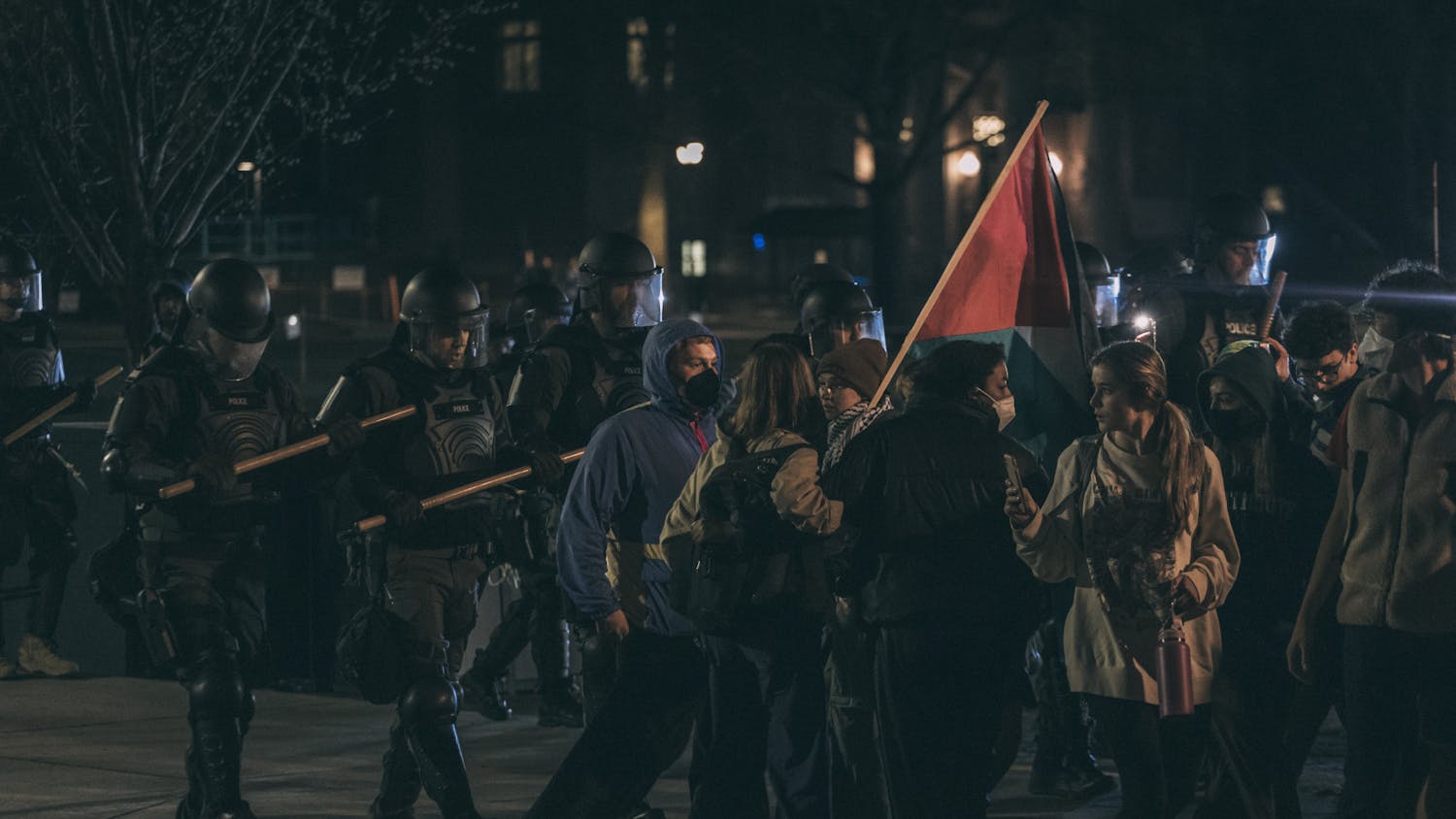Fifty-eight years ago, the Vermont state government razed Lewiston, Vt. to the ground — burning nine buildings and destroying more than 200 years of history in just 15 minutes. The former village, located across the Connecticut River from the College, was once a transportation and commerce hub in the Upper Valley.
Yet few Dartmouth students speak of the lost town, a once thriving hamlet of the better-known Norwich. Fewer know that its destruction was partially for their own benefit. In 1967, the Town of Norwich voted 347-311 to bulldoze and burn Lewiston, The Norwich Times reported. The reason? “Progress in the guise of Interstate 91,” according to the Valley News. At the time, the town was valued at $377,000 and most of the businesses had already moved to neighboring Norwich or White River Junction. The residents of Norwich ultimately agreed — with a strong fight from some Lewiston residents — that the potential financial benefits of building Exit 13, which links Dartmouth and I-91, warranted the village’s destruction.
Lewiston had a long history before its 1967 destruction. Four years older than the College, the village was founded in 1765 on the Vermont-New Hampshire border — where present-day River Road, Foley Park and some of VT-10A are now located.
At the time, the hamlet served as a main entry point into the College. According to Norwich Historical Society director Sarah Rooker, the Connecticut River used to be narrower, allowing for foot crossings from Lewiston to Hanover during periods of low rainfall. During the wet season, travelers still had to cross through Lewiston to reach Hanover by boat — the town’s location at one of the narrowest points on the Connecticut River made Lewiston a natural spot for a rope ferry and, later, a toll bridge. The village’s prime river real estate, in turn, led to revenue, as Lewiston charged tolls on river crossings until the mid-1800s.
In 1848, the town’s revenue was further bolstered by the construction of the Passumpsic and Connecticut Railroad. The first railroad line to serve the area, the station built a freight depot in Lewiston and increased the town’s importance, according to Dartmo, a website documenting Dartmouth architecture.
The College used the railroad line to transport its coal supply from 1898 through the late 1920s, when Dartmouth switched from coal to oil. Many Dartmouth students also relied on the station to travel to campus after 1848. Even United States presidents used the railroad — President Ulysses S. Grant stopped in Lewiston in 1869 and President Rutherford B. Hayes made a whistle stop in 1887.
The popularity of the station increased the town’s prosperity, according to The Norwich Times. During the 1930s, Lewiston was bustling, housing dairy farms, a brothel, mills, a general store and a speakeasy, among other businesses, the paper reported.
The town’s fate changed, however, in the middle of the 20th century. First, Lewis Road, which connected Lewiston to Norwich, was nearly impossible to traverse by horse-drawn wagon during the mud season, which further isolated the village from Norwich at this time.
In addition, the construction of Wilder Dam, which began in 1947, “flooded the lower portions of old Lewiston,” including buildings at the river’s edge, according to anthropology professor Jesse Casana. The flooding inundated low-lying farmland and forced some Lewiston citizens to move, Casana said.
The diminishing economy of the 1930s, a decline in passenger train travel and these natural challenges ultimately contributed to the town’s demise — so much that the post office closed in 1954 and the town’s rail station closed in 1959, according to The Norwich Times.
However, the true end of Lewiston came in the 1960s, when construction on I-91 required the destruction of Lewiston’s nine remaining buildings. The decision to uproot people from their homes was “controversial,” but Rooker said the choice came down to the exit’s planned proximity to Dartmouth. According to a 1966 article in The Dartmouth, the existence of the Ledyard Bridge — the only bridge crossing the river south of East Thetford at this time — influenced the Vermont Highway Department’s decision to build Exit 13. Since Hanover is a “terminal point,” or a prime destination, due to the presence of the College, the decision to build an exit near Hanover seemed more logical, according to The Dartmouth. The other consideration was an exit at White River Junction, which would require going through West Lebanon to reach the College, The Dartmouth said.
Today, only a few fossils of this once-prosperous town remain. One such remnant is a small neighborhood built in the late 1940s on McKenna Road. Another is the old railway station which is now owned by a “private club,” according to Rooker. Four Dartmouth-owned buildings and Lewiston Lot, a parking lot for employees and graduate students, round out the list of extant structures.
These Dartmouth-owned buildings, which were owned by Dartmouth-Hitchcock Medical Center until 1989, are an eclectic mix. According to Casana, the largest of the four buildings is used for storage by Facilities Operations & Management. A smaller building has intermittently served as the location of a sale put on by the Sustainability Office at the beginning of each academic year, according to ceramics studio director Jennifer Swanson. According to Casana, Dartmouth also owns the now-unused Davidson Ceramics Studio and the Dartmouth Archaeology Station at Lewiston.
Swanson, who worked at the Davidson Ceramics Studio from 2004 until its closure in 2016, said the building was used as the sole campus pottery studio from the late 1970s until 2016, when the College relocated the ceramics studio to the Hopkins Center for the Arts.
“The space itself had tiny rooms because that’s the way they built things in those days,” Swanson said. “It had a lot of windows, so you could … look at the river, and it had this charming quality.”
Despite the space’s numerous benefits, Swanson said the distance from campus posed challenges — especially since creating ceramics requires “frequent visits” to the studio. In warmer months, the distance was welcomed, with ceramics students even swimming across the river to class, Swanson said. However, many students complained about the long trek across the Ledyard Bridge during the colder months. This distance also made it difficult for ceramics to build connection to the other programs offered through the Hopkins Center for the Arts and the rest of campus, Swanson said.
Casana has had quite a different experience with Lewiston. In 2021, he renovated one of the Lewiston buildings and created the Dartmouth Archaeology Station at Lewiston to be used as an archaeological research hub. He said DASL is “just the kind of thing that we need to do archaeology well.”
Casana is currently renting the space from the Dartmouth Real Estate Office, a real estate agency that manages rentals around the Upper Valley. Since Lewiston is not technically considered part of campus by the College, he had to advocate for weekly janitorial services and trash removal. In recent years, however, the College has made efforts to bridge the distance between the main campus and Lewiston. The Campus Connector stops at the Lewiston Lot next to Casana’s lab, and the College recently “ran a fiber optic cable underneath the bridge” to give the parking lot and the lab access to campus WiFi, according to Casana.
Despite its challenges, Lewiston’s history can be used as a stepping stone for the future. For many years, studio art professor Jack Wilson has tasked students in SART 65, “Architecture I” with generating ideas on how to best utilize the remaining Lewiston area for “student life” or other activities.
Over the years, students have proposed adding a restaurant, bar, performance space or faculty housing to Lewiston, according to Wilson.
“Other things we’ve talked about are a welcome center [for campus tours],” Wilson said. “[Or] a wellness center where it’s off campus and away from the grind of things.”
The 2020 Strategic Campus Framework — a guide for Dartmouth’s “physical campus” for the next 30 years — only mentions Lewiston as an “opportunity site,” or a place where redevelopment is possible. In an email statement to The Dartmouth, Real Estate senior director Daniel Justynski wrote that the College has “nothing planned” for Lewiston at this time. The challenges of Norwich zoning laws, the lack of a sewer system and its proximity to the river make future development difficult, both Wilson and Casana agreed.
The once thriving town of Lewiston therefore remains primarily a blank canvas, its future up in the air. Regardless of whatever developments lie ahead, the next time you visit the Connecticut River and look toward Vermont, imagine what once was — and what could be.
Correction appended (March 3, 3:50 p.m.): A previous version of this article incorrectly stated that the ceramics program is part of the studio art department. The ceramics studio is a Student Workshop that is part of the Hopkins Center for the Arts. This article has been corrected.




